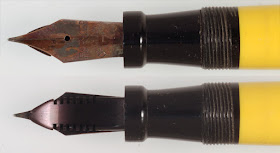A blog about antique and vintage writing instruments: fountain pens, mechanical (propelling) pencils, dip pens, and more.
Monday, January 30, 2017
A re-imprinted Duofold Senior
The Parker Duofold Senior shown above has several unusual features, all of which would seem to be old and original. Capped, the pen appears to be a completely standard Mandarin from around 1927.
The nib, however, is a Lucky Curve #7 of the sort found on Senior-sized non-Duofold pens of the pre-streamline era. It sits atop a Vacumatic-era comb feed. Comb feeds are often found retrofitted to Duofolds originally equipped with "spearhead" Lucky Curve feeds, but with either an original Duofold nib, or with an arrow-imprint nib marked on the heel with a star to denote the Duofold guarantee. One just doesn't see #7 Lucky Curve nibs used as replacements.
This all makes more sense upon examination of the barrel, which bears two imprints. One is the expected later 1920s Lucky Curve imprint, which has largely been polished away. The other is the typical 1930s one-line generic Parker imprint with no model name, which only shows modest wear and is clearly legible. The pen can best be characterized as a downgraded Duofold Senior, assembled from surplus parts to be sold without the Duofold name or guarantee. Given the comb feed and the lack of a date code on the barrel, this assembly likely took place around 1933-34.
Other downgraded Duofolds are known; a pristine Lapis Blue Senior set was sold at an Ohio pen show auction a few years ago, if I remember correctly, though that pen bore but a single barrel imprint, with the Lucky Curve banner but without the Duofold name. And a double-imprinted Big Red was the topic of discussion some years back in one of the online forums. Such pens are rare, though, so this Mandarin is a welcome discovery.
ADDENDUM: Opening up the pen revealed the petrified sac shown in fragments below. It is lightly stenciled "PARKER ANODE", strongly suggesting that this is the original factory-installed sac. The pressure bar is also original, and two-piece (Parker button-fillers assembled later in the 1930s were fitted with a three-piece pressure bar instead).
Overall condition of the pen as it came to us was excellent, with only a few small spots of ink inside the cap.



No comments:
Post a Comment